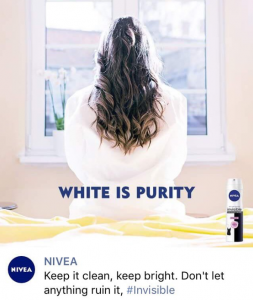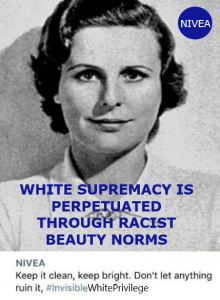Welcome to UBC Blogs. This is your first post. Edit or delete it, then start blogging!
Author Archives: yunhan liu
Official Moisturizer of the Alt-Right

This ad is problematic because it uses discourses of purity to make statements about gender and racialization, suggesting that whiteness is central, desirable, and superior, and that racialized bodies should strive towards whiteness. The ad also suggests that whiteness represents racial purity, and that whiteness should not be diluted by other, presumably inferior, races or cultures. The use of the phrase “invisible” locates whiteness as central and dominant, othering all other non-white bodies by implying that they are visible and different. This discourse is similar to the idea of a “visible minority” in which whiteness is made invisible by its own racist power.
In addition to the encoded meanings present in this image in relation to race, the ad highlights the intersections between race and gender, and how hegemonic relations of power are reinforced and perpetuated through beauty norms. Beauty norms are culturally held meanings about what kinds of bodies are most attractive and desirable, and which are inferior and marginal; they are also social norms. In this advertising, Nivea, a beauty product, conflates femininity with whiteness, and implies that both femininity and whiteness are most valuable when they are “pure” and uncomplicated by impure racial identities or subversive expressions of gender other than pure, white femininity (which should be cultivated in order to be consumed by the heterosexual male gaze).

I have superimposed a picture of Leni Riefenstahl, a German filmmaker who made Nazi propaganda films in World War II. Leni Riefenstahl is a problematic figure, because some argue that she was a had no choice but to participate in the production of white supremacist cultural productions because of her marginalized position as a woman. To me, Leni Riefenstahl represents how gender and race work together to perpetuate hegemonic relations of power. Riefenstahl was complicit in the oppression of other marginalized people and her filmmaking skills were used as a tool to consolidate power for dominant groups, similar to how this ad uses gender in order to enforce norms about whiteness being superior and other races. To me, Riefenstahl represents how white feminism often fails to address its own complicity in the ongoing oppression of racialized people, gender-diverse, trans, and genderqueer people, and others with marginalized identities.
By using Leni Riefenstahl’s image, I am also making reference to the enduring quality of white supremacist thought, and the myth of social progress. The statements this ad makes about white purity would not have been out of place in past eras, despite the widely held idea that we have left overt racism in the past. I have also altered the hashtag “invisible” so it instead says “#invisiblewhiteprivilege,” making reference to the idea that these types of ads and their messages are widely accepted as inoffensive, despite their messaging being congruent with hate movements (including white separatism and white nationalism) past and present. It’s a privilege to be able to look at an ad like this and to not recognize the inherently oppressive, divisive, and hateful message: white privilege is being able to interact with this message and believe it is neutral. Making this kind of power invisible, natural, and “normal” is how hegemony perpetuates itself.